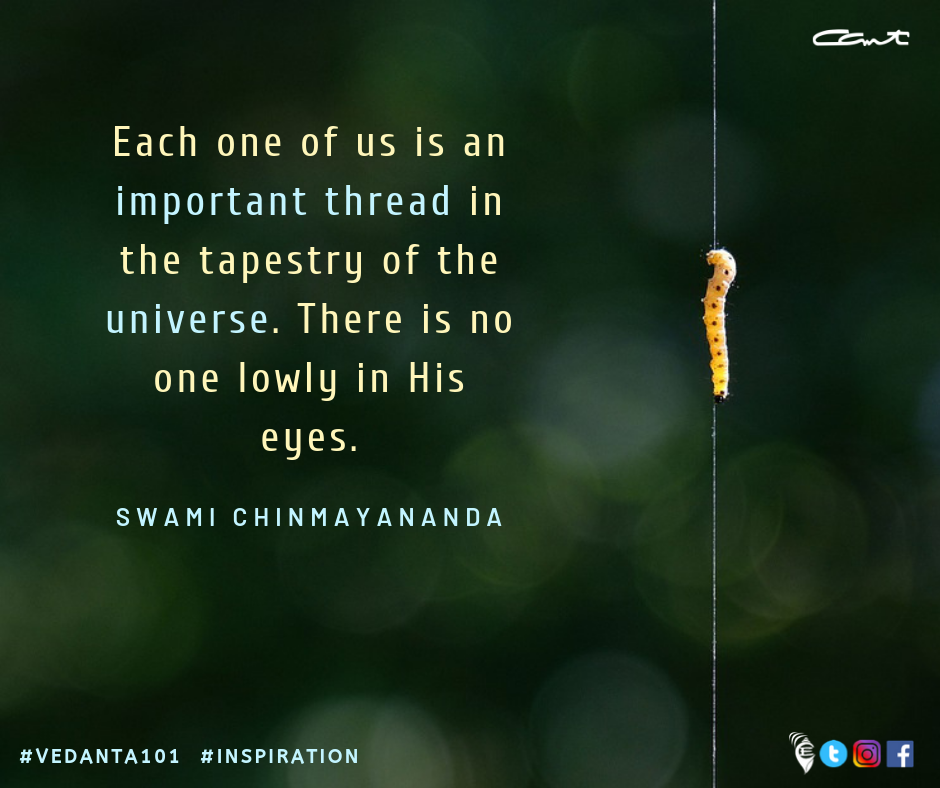Commentary on the Srimad Bhagavad Gita-1.3 : Swami Krishnananda
=======================================================================
------------------------------------------------------------------------------------------------------------------------
23/10/2019.
Chapter-1: The Colophon of the Srimad Bhagavad Gita-3.
--------------------------------------------------------------------------------------------------------------------------
Brahma-vidya is the art and the science of educating oneself in the manner of correctly perceiving the world as such, including one’s own self, in the totality of relations, so that no partial vision of things can be regarded as a passport to the concept of the Absolute. Mostly—or always, I may say—our perceptions are partial. They are limited to certain conditions. It is a condition related to a marketplace, a railway station, a bus stand, an office, a factory or a house. These are the things that limit our thoughts, but we do not rise above the apparent outwardness of these conditions and go inside to the relationship of these things to other things.
This is a very difficult thing to maintain in the mind, because the human mind is sensorily restricted. It is externalised in its nature, and total perception is neither externalised nor internalised. It is a blend of the external and the internal, so that we stand in the middle, between our perceiving capacity and the object that is perceived. In a total perception of things, we are not in ourselves; we have transcended ourselves. Nor are we in the object; we have transcended the object. We are in the middle as the blend—a blending consciousness which brings about a harmony between the seer and the seen, or between any two faces of reality. In all situations, there are two aspects: the cause, or the causative factor, and the effect upon which the cause seems to have an impact. It is very difficult for us to see the relation between cause and effect. Mostly we see the cause as one thing and the effect as another.
Brahma-vidya is an intricate subject. It is not just repeating some words of the Upanishads or the Brahma Sutras or even the Gita. It is the entry of the consciousness into the very import of the teaching, which is suggested in many of the verses of the Bhagavadgita itself.
Mattah parataram nanyat kincid asti (CH-7.SL-7);
aham atma gudakesa sarvabhutasayasthita? (CH-10.SL-20);
pasya me partha rupasi sataso’tha sahastrasah (CH-11.SL-5);
divyam dadami te cakshuh pasya me yogam aisvaram (CH-11.SL-8);
jneyam yat tat pravakshyami yaj jnatvamrtam asnute,
anadimat param brahma na sat tan nasad ucyate (CH-13.SL-12);
sarvatah - panipadam tat sarvato’kshisiromukham,
sarvatah srutimal loke sarvam avrtya tishtati (CH-13.SL-13):
The Total has eyes everywhere, has feet everywhere, has hands everywhere, because it is neither a subject nor an object. In the total perception of things, we are not ourselves, nor are we other than what we are. We are something beyond both what we are and what is other than what we are. This is the final import, as it were, of the Brahma-vidya aspect of the Bhagavadgita.
To be continued ....
=======================================================================
------------------------------------------------------------------------------------------------------------------------
23/10/2019.
Chapter-1: The Colophon of the Srimad Bhagavad Gita-3.
--------------------------------------------------------------------------------------------------------------------------
Brahma-vidya is the art and the science of educating oneself in the manner of correctly perceiving the world as such, including one’s own self, in the totality of relations, so that no partial vision of things can be regarded as a passport to the concept of the Absolute. Mostly—or always, I may say—our perceptions are partial. They are limited to certain conditions. It is a condition related to a marketplace, a railway station, a bus stand, an office, a factory or a house. These are the things that limit our thoughts, but we do not rise above the apparent outwardness of these conditions and go inside to the relationship of these things to other things.
This is a very difficult thing to maintain in the mind, because the human mind is sensorily restricted. It is externalised in its nature, and total perception is neither externalised nor internalised. It is a blend of the external and the internal, so that we stand in the middle, between our perceiving capacity and the object that is perceived. In a total perception of things, we are not in ourselves; we have transcended ourselves. Nor are we in the object; we have transcended the object. We are in the middle as the blend—a blending consciousness which brings about a harmony between the seer and the seen, or between any two faces of reality. In all situations, there are two aspects: the cause, or the causative factor, and the effect upon which the cause seems to have an impact. It is very difficult for us to see the relation between cause and effect. Mostly we see the cause as one thing and the effect as another.
Brahma-vidya is an intricate subject. It is not just repeating some words of the Upanishads or the Brahma Sutras or even the Gita. It is the entry of the consciousness into the very import of the teaching, which is suggested in many of the verses of the Bhagavadgita itself.
Mattah parataram nanyat kincid asti (CH-7.SL-7);
aham atma gudakesa sarvabhutasayasthita? (CH-10.SL-20);
pasya me partha rupasi sataso’tha sahastrasah (CH-11.SL-5);
divyam dadami te cakshuh pasya me yogam aisvaram (CH-11.SL-8);
jneyam yat tat pravakshyami yaj jnatvamrtam asnute,
anadimat param brahma na sat tan nasad ucyate (CH-13.SL-12);
sarvatah - panipadam tat sarvato’kshisiromukham,
sarvatah srutimal loke sarvam avrtya tishtati (CH-13.SL-13):
The Total has eyes everywhere, has feet everywhere, has hands everywhere, because it is neither a subject nor an object. In the total perception of things, we are not ourselves, nor are we other than what we are. We are something beyond both what we are and what is other than what we are. This is the final import, as it were, of the Brahma-vidya aspect of the Bhagavadgita.
To be continued ....
=======================================================================





Comments
Post a Comment